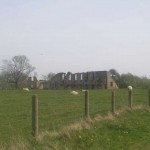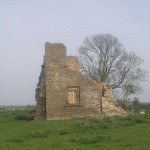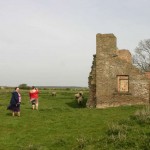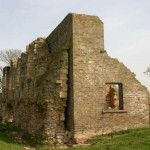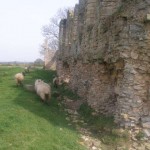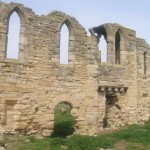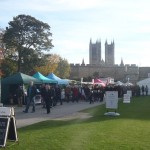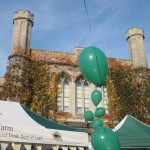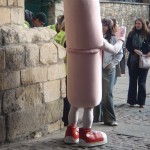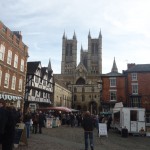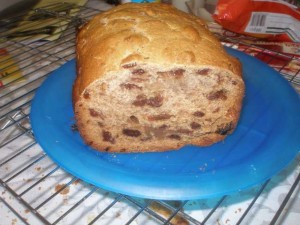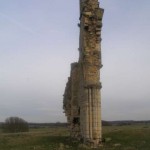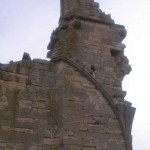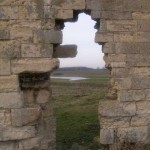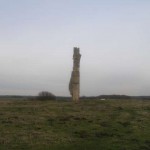Let it Snow, Let it Snow, Let it Snow
Oh the weather outside is frightful
Monday:
No pic of my house, but here’s one I took in Lincoln

Tuesday:
And since we’ve no place to go…Let it snow, let it snow, let it snow
And the most recent, taken at 1AM on Wednesday:

It doesn’t show signs of stopping….:

And just for good measure, the snowperson my sister-in-law and I made this afternoon:

The village shop has run out of the 4 pint size bottle (half gallonish) of milk and no longer has bread, but we’ve got the bread machine for bread, and worst case scenario, we’ll buy smaller milk if we run out (just opened a 4 pt bottle Tuesday afternoon). Worst, worst case scenario, I have a canister of powdered milk in my baking supplies we can raid for tea. We stopped at Morrison’s on Monday and bought a few “basics”, not our weekly shop, but I think I can cobble together some meals for a few days. Tim and I can also always go to the CostCutter or the Co-Op, though those are longer walks (about a mile RT to CostCutter and 2 miles RT to the Co-Op) and today when we went to the Spar shop (literally, 5 houses down from us) I got soaked by a passing car, so I really don’t want to walk near the road right now!
[LJ readers reading this on the LJ RSS feed: Please click on the link at the top of the entry to go directly to my blog to leave a comment, as comments left on the LJ RSS do not get seen by me. Facebook users can comment directly on Facebook.]
3 commentsAbbey in the Backyard, Part 2
In March 2010, I blogged about Barlings Abbey, an abbey ruin located not far from Tim’s grandad’s house. In April 2010, we were to find another random abbey ruin while driving with my mom.
We had discovered the remains of Tupholme Abbey.
Tupholme Abbey was founded between 1155 and 1165. The area was picked primarily for it’s location to the River Witham, and was expected to do well. However, this was not to be the case at all. While it was operational, the abbey suffered many debts. In 1347, an abbot was accused of “forgery and counterfeiting of the coin of the realm”. In 1482, the canons were forbidden to leave the abbey due to unruly behavior, and in 1497, an abbot was banished to Leicester for having a child with a local woman.
Tupholme Abbey was dissolved in 1536 under King Henry VIII.
The land and abbey changed hands many times, becoming part of a mansion and later a manor house. In the 1970s, the site was even used for a music festival. Finally, in 1988, the National Trust took over the property.
You can visit the ruins for free – but you might want to make sure you have your Wellies when you go! We had to walk through sheep grazing to get to the ruins. The pasture was rather squishy with what I hoped was mud, but I fear wasn’t!
[LJ readers reading this on the LJ RSS feed: Please click on the link at the top of the entry to go directly to my blog to leave a comment, as comments left on the LJ RSS do not get seen by me. Facebook users can comment directly on Facebook.]
1 commentLincolnshire Sausage Festival
A few weeks back, Tim and I attended the Lincolnshire Sausage Festival, held on the castle grounds, sponsored by Tastes of Lincolnshire. I get a lot of comments from my friends living in other parts of the UK about how jealous they are that we have all these food festivals and they don’t, but well….that’s what Lincolnshire exports! We’ve got loads of farmland and lots of farm animals, so having lots of festivals makes sense.
Anyway. We didn’t really know what to expect at the Sausage Festival, other than some sausages, and we were really surprised at the number of stands, including our friends at Lymn Bank Farm and many of the other stalls I usually see on market day. In addition, there were many food stalls selling all sorts of local fare – sausage (naturally), Lincolnshire beef burgers, Lincolnshire lamb burgers, locally made candy and beverages…if it got made in Lincolnshire, I’m sure there was a stand for it!
We had a great time. There also was a cooking demonstration set up, where I met a fellow American volunteering. She has been in Lincoln for 5 years and tells me there are more of us around. And even funnier? This month’s Good Taste features Whoopie Pies, a PA Dutch treat! How ironic!
We tried several sausages and Tim wanted to try the Hog Roast – they had an entire pig on a spit. Tim said it was good, but I think he liked the Guinness sausage more.
I’m hoping we can make it to the Christmas Food and Drink Show at the end of the month.
[LJ readers reading this on the LJ RSS feed: Please click on the link at the top of the entry to go directly to my blog to leave a comment, as comments left on the LJ RSS do not get seen by me. Facebook users can comment directly on Facebook.]
No commentsLincolnshire Plum Bread
[If a Lincolnshire publication would like to reprint this, just contact me!]
Lincolnshire is famous for several kinds of food. There is Lincolnshire Poacher Cheese – a sharp, biting cheese, Lincolnshire Sausage – a sausage seasoned with herbs, and another famous Lincolnshire food item is Lincolnshire Plum Bread.
No one seems to know exactly when people started making Plum Bread, other than that it is “centuries old”. Several local bakeries that have been in business since the early 20th century claim Plum Bread as one of their first specialities, so we do know that Plum Bread has been around for at least over 100 years, possibly even 200 or 300.
We also know that “plum” doesn’t refer to plum fruits or even to prunes (dried plums). “Plum” simply is a reference to dried fruit, such as calling a Christmas Pudding a “Plum Pudding”. The word “Plum” for dried fruit originated during the Middle Ages, when dried fruit was used to help preserve meat. This type of preservation continued and the recipe was modified into what we now call a Plum Pudding or a Christmas Pudding.
The use of the word “bread” to describe this food item is a bit of a misnomer as well. You wouldn’t want to use this for sandwiches. Lincolnshire Plum Bread is traditionally served at breakfast time or tea time. In medieval England, the words “bread” and “cake” were used interchangeably, and they still are today. Take for example, banana bread. Banana bread is surely more closely related to being cake, yet we call it a bread. Banana bread did not formally enter kitchens until the 1930s in America, though there is speculation that it may have been invented in the late nineteenth century by American housewives. Either way, it’s still a long way away from medieval England when either word could be used.
If Lincolnshire Plum Bread is not a bread and does not actually have plums, what is it? Lincolnshire Plum Bread is a sweet, almost cake-like cinnamon-flavoured bread with dried fruit in it – sultanas, currants, and fruit peel – that has been soaked in cold tea to help the dried fruit “plump” up.
There are several bakeries in Lincolnshire that claim to be “the original”, but perhaps the most famous brand is Myers. in 1977 a loaf was given to the queen at her silver jubilee and Myers Lincolnshire Plum Bread is served on British Airways in their first class cabin. Other brands also exist and the loaves retail for about £2.50. You can purchase Lincolnshire Plum Bread throughout Lincolnshire in small bakeries and at the co-op.
If you’re outside of Lincolnshire, hope is not lost. There are many recipes floating around on the internet for Lincolnshire Plum Bread, and I will include my own recipe, modified for a bread machine, below.
Lincolnshire Plum Bread
First, you will need some cool strong tea. The easiest way to do this is to take a glass measuring cup, put 2 tea bags in it, and fill it halfway with water from the kettle. Then, forget about it for about 5 minutes and let it get nice and dark. Remove the tea bags and add cold water to cool it down quickly.
Add about 300-400g dried fruit (sold in grocery stores as “dried mixed fruit” or use a combination of dried currants, sultanas, raisins, and peel) and let it sit until the fruit is nice and plump.
Meanwhile, get out your bread machine and add to it:
100g butter (melted)
120ml warm milk
2 eggs
450g bread flour
100g sugar
1 tsp cinnamon
1 tsp allspice
1 1/2 tsp bread machine yeast
Follow the instructions on your bread machine for what order you should add ingredients. Mine calls for all the liquid to go in first, which includes the eggs. I also save time by microwaving the butter and milk together – an extra bonus is it keeps the butter from exploding all over the microwave.
Set your bread machine to a 1KG loaf (2lbs), medium crust, and use the sweet setting (on my machine, this is setting 4).
Start your bread machine.
Follow your machine’s instructions for adding fruit. Most machines will beep when they want you to add fruit, so wait for the beep, drain off the tea, and pour in the fruit. You might need to keep an eye on it for a few minutes and use a spatula to make sure all the fruit gets mixed in.
Let the bread cool in the pan for about 20 minutes before turning out. I find it’s easier to cut the bread if I let it cool completely, but by all means serve it warm!
Traditionally, Lincolnshire Plum Bread is served with butter and cheese. Give it a try, you might like it!
This bread has the seal of approval from several Lincolnshire born & raised men and women! 😀
[LJ readers reading this on the LJ RSS feed: Please click on the link at the top of the entry to go directly to my blog to leave a comment, as comments left on the LJ RSS do not get seen by me. Facebook users can comment directly on Facebook.]
2 commentsBramble Ramble
Monday was a day off for Tim. After I got back from a GP appointment, I said to Tim “let’s go on a walk ’round the farmer’s fields”. Tim got out the Ordnance Survey Map for the area instead and picked out a route that went across the A46 through a wooded area and through some fields. We were originally going to walk to the Stepping Stones (some metal stepping stones placed in the river to walk across), but Tim got a phone call while we were out asking him to pick up a shift that evening, so we cut across a nettle-filled path that went right on the edge of a grain field and the beck to get home, but we walked 5 miles in total! We stopped at the corner Spar shop on our way out and picked up some sandwiches and snacks, and filled up our water bottles before we left. Fortunately, the rain held off and we only got spritzed on as we were almost back home.
There are over 140,000 footpaths in England and Wales. Picking up an Ordnance Survey map is a great way to get to know an area. The maps have all the public right of ways marked, so as long as you can read a map (and maybe have a compass) you’re good to go out and explore. You just need to remember to always stay on the footpaths. Some footpaths go around farmer’s fields, and some even cut through people’s gardens! Tim was telling me a story once about a public right-of-way that actually went through a person’s house because their house got built on top of one.
As we were walking, I noticed wild blackberry bushes. I commented that I wished I had brought along a basket…and then I had a brilliant thought. I could use my hat! So, my hat became a basket and we gathered blackberries and hazelnuts (off the trees) while we walked.
Apologies for the photo quality. I forgot to grab my camera and I’m still using the Sony Ericsson W200i phone, and it only has a VGA camera.
I’m going to freeze these, I think. I leave on Saturday for a trip to Wales with my friend H and her son, and I don’t want to make something Tim will forget to eat, so I’ll freeze them and figure out what to do later.
We also have a bumper crop coming in outside on our “cultivated” bushes, as our neighbour called them. Apparently the difference is the “cultivated” bushes have tighter, smaller sections than the wild ones. No matter to me, a blackberry is a blackberry and mmm, I’m already dreaming of blackberry and apple crumbles made from our own apples and blackberries!
[LJ readers reading this on the LJ RSS feed: Please click on the link at the top of the entry to go directly to my blog to leave a comment, as comments left on the LJ RSS do not get seen by me. Facebook users can comment directly on Facebook.]
1 commentAn Abbey in Ruins…Right in Our Backyard!
Today’s post is brought to you courtesy of Tim and I wanting to avoid the traffic back-up caused by an accident near Lincoln.
Tim and I went to Tesco a few Fridays ago to pick up some chicken wings, as I had promised my Father-in-Law that I would make him some buffalo wings. On our way into town we noticed there were huge back-ups going the other way. Not wanting to get caught in the traffic, Tim decided to take the long way out of town through some smaller villages and towns. It was a route I had never been on before with some beautiful scenery and winding country roads.
At one point he said to me, “if we turn here, we can see the abbey ruins”. Of course, I had to ask about them! Our short detour took all of about 20-30 minutes, and most of that time was actually walking from the side of the road over to the ruins, as there really isn’t much there to look at. It used to be an abbey called Barlings Abbey.
Barlings Abbey was founded in 1154. in 1537, the abbey was closed by King Henry VIII (when he was closing lots of abbeys, priories, and churches) and all of the valuables were taken away, including the roof! By 1726, only the tower and a few bits here and there remained. The tower fell in 1757 and you can see that some of the stone was used in the nearby farmhouse and farm buildings. Today, all that remains is a bricked up arch, part of the tower base, and lots of rubble. No formal excavating has ever been done on the site, and the remaining wall will probably eventually fall down as well, as it doesn’t have any support nor really a way to support it.
I still get a small thrill touching stones from the 12th century. I can’t help it. It thrills me to the bone to touch pieces of history. I really should have become a historian!
Barlings Abbey is located seven miles east of Lincoln. The site is in private ownership with public access through the farmland (provided you stick to the designated public footpaths) and is free. We actually were only two or three miles away from Tim’s grandad’s house in Langworth, which is only about four miles away from our house!
For more information, see: http://www.lincsheritage.org/community_heritage/guides_information/witham_abbeys/site.php?key=barlings_abbey
Selected photos. More can be seen on facebook:
[LJ readers reading this on the LJ RSS feed: Please click on the link at the top of the entry to go directly to my blog to leave a comment, as comments left on the LJ RSS do not get seen by me.]
No commentsNHS After Hours
I have had the misfortune to require a doctor after office hours twice this week. In the US, if I needed my doctor after office hours I would have to call into the answering service, leave a message, have my doctor (or the doctor on call) paged by the answering service, then wait for a phone call back from a nurse or secretary to tell me what to do (usually wait until the following day or head to the ER as those were the only options). Here in the UK, you call your regular GP number and if it’s after hours it will connect you automatically to the after hours operators. They will take down your information (I needed to provide my NHS number and tell them a bit about my problem plus give a phone number I could be reached at) and you’ll get a call back from a nurse a few minutes later. That nurse will ask you more questions (obviously, their first goal is to try to diagnose you over the phone and to make sure it’s not a true emergency). In my case, it was determined that I did not have a life-threatening emergency requiring A&E (Accidents & Emergencies, AKA the Emergency Room in the US), but that I did need to see an after hours doctor. Fortunately, we live only about 6 miles away from the county hospital that provides this service.
The after hours GP at the county hospital is located right next to A&E. For being after hours, it was surprisingly fairly empty both nights. The first night, there was one person waiting to be seen and 2 waiting for test results. The second night had a few more people, but it still barely made a dent in the waiting room seating areas!
The first night I went in, I saw a GP. He was able to access my NHS files to see what I was being seen for by my GP and what prescriptions I was on. After giving me an exam, he decided I needed to be put on more antibiotics and a heftier pain killer than regular paracetamol (closest US match: Tylenol/Acetaminophen ), so he wrote up a prescription and the nurse directed us to an “all night” pharmacy.
The pharmacy turned out to be the local Boots store we visit on occasion. They have a walk-up window instead of you actually going into the store so it was a little chilly while waiting!
But we were soon home and only spent £14.40 (the visit to the after hours was, of course, free and included in my NHS care).
The following day when I called, they did their best to reassure me and calm me down (I was having a problem related to the previous night), but in the end it was determined that I needed to see the Nurse Practitioner at the after hours just to be on the safe side. My visit with the nurse took 10 minutes or so, but it was enough to assure me that I was okay, and enough to assure the nurse that I wasn’t in any danger.
This is just one more reason in a long list of reasons why I really like the NHS and wish a similar system existed in the US.
[LJ readers reading this on the LJ RSS feed: Please click on the link at the top of the entry to go directly to my blog to leave a comment, as comments left on the LJ RSS do not get seen by me.]
No comments








